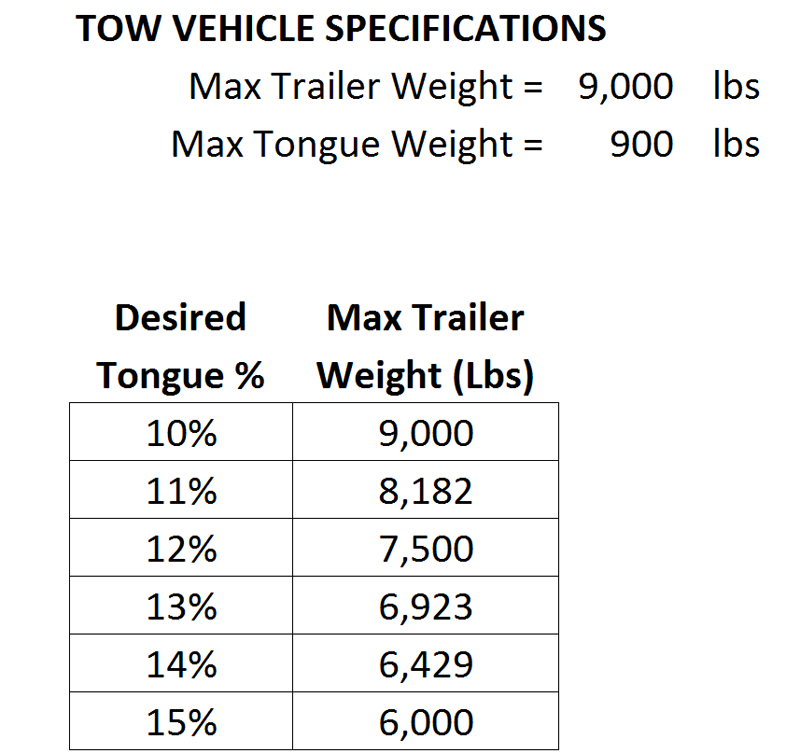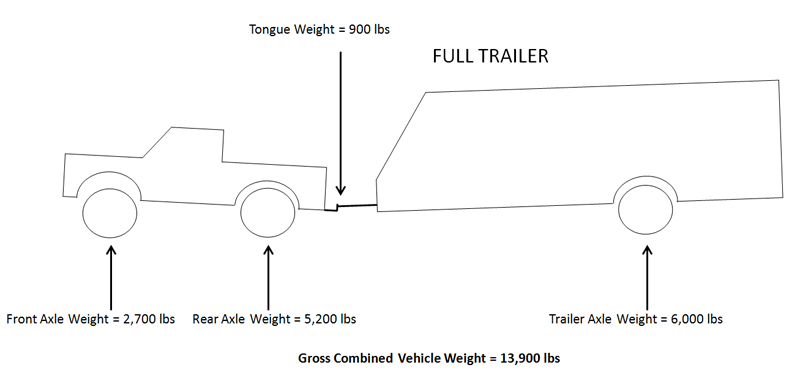Before we discuss trailer weight, tow vehicle weight, and total combined weight, a discussion about hitches is in order. There are a lot of misconceptions about trailer tongue weight, hitch weight and how to calculate what you have in your rig.
This is not meant to be a technical “White Paper” but just a general overview. If you need more information, then Google is your friend. But this article might help you sort out the sea of confusion that is the Internet.
Once the concepts are understood, we can discuss our “too heavy” trailer in Part 3.
Part One of this series can be found here.
Tongue Weight
 Tongue weight should be 10% to 15% of the trailer’s total weight. Many pundits say 12%-13% is the goal. Truck manufacturer’s rate the tongue weight at 10% of the maximum trailer weight that can be towed. They say it is because they want a standardized system to compare against the competition. But let’s look at some numbers.
Tongue weight should be 10% to 15% of the trailer’s total weight. Many pundits say 12%-13% is the goal. Truck manufacturer’s rate the tongue weight at 10% of the maximum trailer weight that can be towed. They say it is because they want a standardized system to compare against the competition. But let’s look at some numbers.
Holy Moly!
Too light a tongue weight percentage will cause handling problems. If you exceed the maximum tongue weight (in pounds) you can damage the tow vehicle, incur handling problems, and possibly end up dead in an accident.
For most people the tow vehicle tongue weight specification is the limiting factor in how heavy a trailer they can tow
Hitch Types
A tow vehicle has a hitch that is used to connect to the trailer. For our discussion, we will discuss the two main types for a travel trailer. Fifth Wheel Trailers are a different subject and we don’t need to discuss them because I don’t own one; and therefore it is unimportant.
The Two Types of Hitches
- Weight Carrying Hitch (WC)
- Weight Distribution (WD)
That’s it: just two kinds of hitches. Today most trucks and SUVs come with a receiver attached to the frame of the vehicle. The owner must purchase a drop bar and ball. The ball is bolted to the draw bar and then the draw bar is inserted into the receiver.
Weight Carrying Hitch
With this kind of hitch, all the weight of the trailer is carried by the rear axle. That is why on our Expedition the WC hitch capacity is only 600 lbs, versus 920 lbs for a WD hitch. I will explain the differences later. So instead of typing a lot (I am lazy), I drew some pictures for you.
First let’s look at a truck. Then an empty trailer, and then what happens when they are connected together using a weight carrying hitch that is within the manufacturer’s specifications.
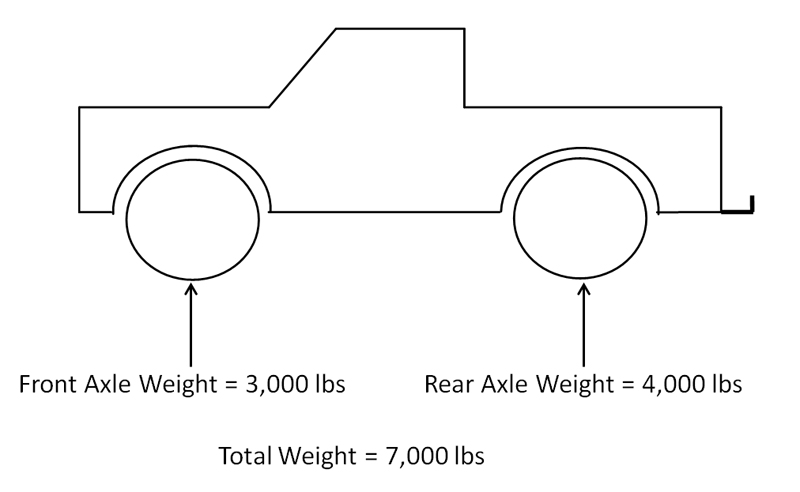 We are going to assume the WC Hitch capacity of this truck is 600 lbs. We have purchased a drawbar and ball and it has been inserted into the truck’s receiver.
We are going to assume the WC Hitch capacity of this truck is 600 lbs. We have purchased a drawbar and ball and it has been inserted into the truck’s receiver.
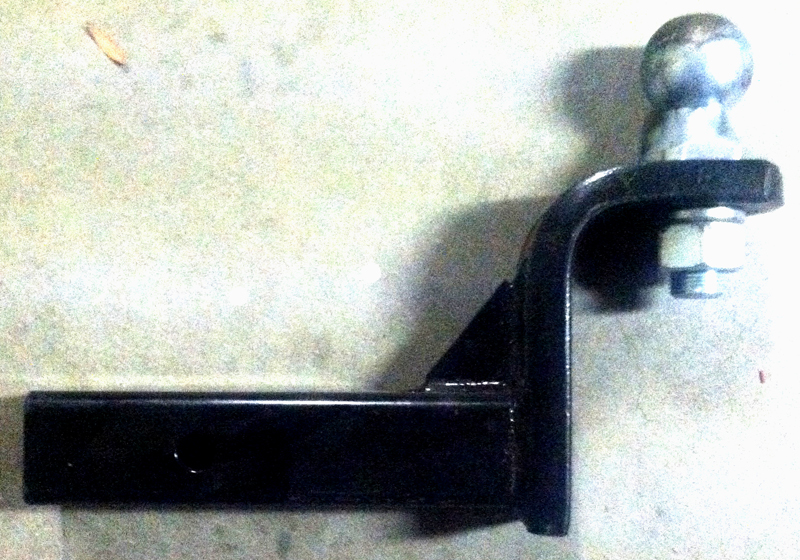
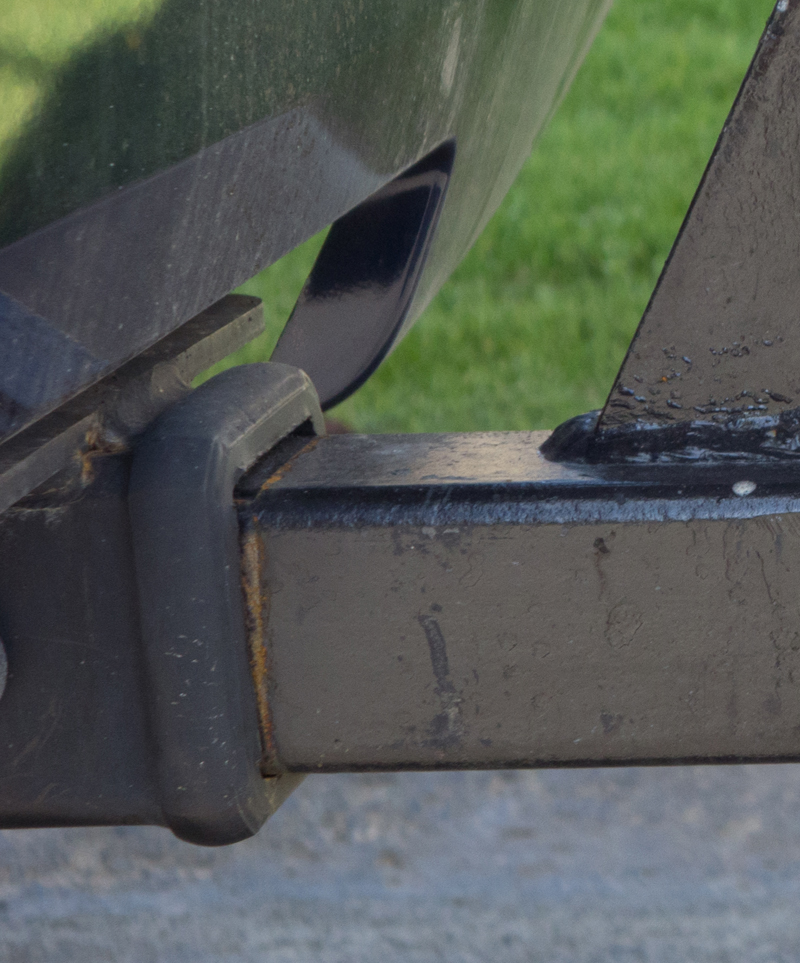
Now let’s look at the trailer. We are assuming the trailer is empty for this discussion.
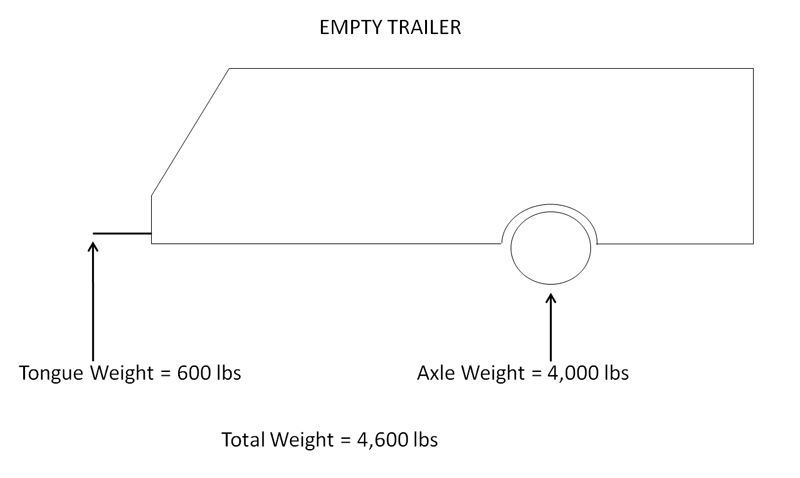 The tongue weight is 600 lbs, which is the maximum our sample truck can carry with a WC hitch.
The tongue weight is 600 lbs, which is the maximum our sample truck can carry with a WC hitch.
Now let’s hook up the trailer to the truck.
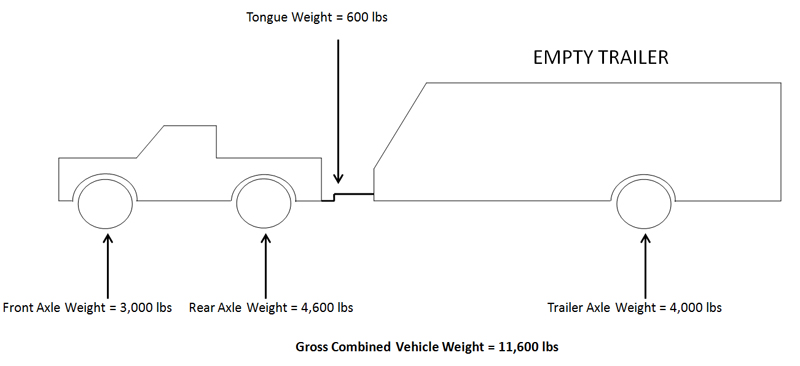 As you can see in the picture above, the truck and trailer are level. In the “real world” the rear of the truck would probably sag a little, but almost all of the tongue weight would be on the rear axle. The rear axle weight increased from 4,000 lbs to 4,600 lbs.
As you can see in the picture above, the truck and trailer are level. In the “real world” the rear of the truck would probably sag a little, but almost all of the tongue weight would be on the rear axle. The rear axle weight increased from 4,000 lbs to 4,600 lbs.
Now let’s put all our gear into the trailer, fill up the propane tanks, refrigerator and fresh water tank.
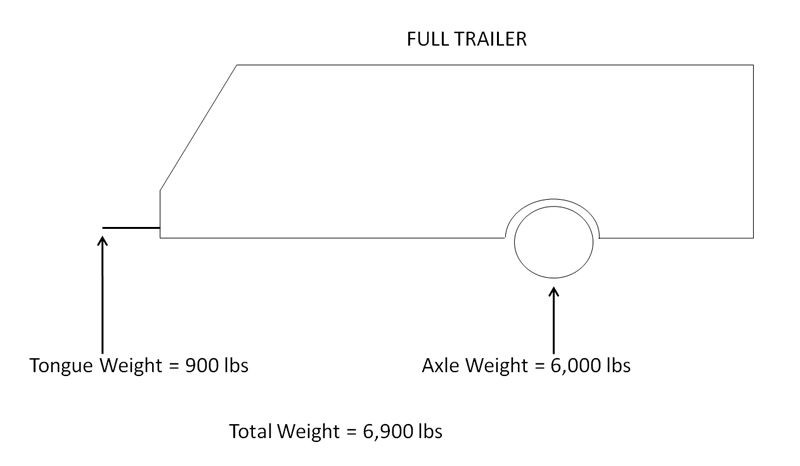 The weight of our trailer has increased by 2,300 lbs, and the tongue weight by 300 lbs.
The weight of our trailer has increased by 2,300 lbs, and the tongue weight by 300 lbs.
If we hook up the trailer to our truck, using the same WC hitch, this is what happens (above).
We have exceeded the tongue weight specification by 300 lbs, the truck is too light in the front, which will cause handling problems, and the rear axle weight of the truck might be over the maximum allowed causing premature wear on the truck or even damage.
But wait – the truck manufacturer says we can have a tongue weight of 900 lbs if we use a weight distribution hitch. But what on earth is a WD hitch?
Weight Distribution Hitch
 The principle behind a weight distribution hitch is the lever. But this sounds too much like school work, not to mention I hated my mechanical engineering class in college – or was it the professor?Well, anyway, most people will probably relate better to a wheelbarrow. The long handles on the wheel barrow create at a fulcrum point at the wheel and it becomes easy to lift heavy loads we could not otherwise move.
The principle behind a weight distribution hitch is the lever. But this sounds too much like school work, not to mention I hated my mechanical engineering class in college – or was it the professor?Well, anyway, most people will probably relate better to a wheelbarrow. The long handles on the wheel barrow create at a fulcrum point at the wheel and it becomes easy to lift heavy loads we could not otherwise move.
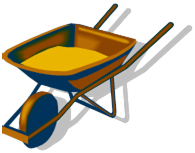 And this is what a WD hitch does. Spring bars at the hitch act as wheelbarrow handles and lift up the rear of the tow vehicle, moving some of the weight off the rear axle and distributes it to the front wheel. When you lift a wheelbarrow the weight is distributed to the front tire and to your body as you hold on to the handles. Likewise, the end of the WD levers are supported up on the trailer frame, which distributes part of the load to the rear axle of the trailer.
And this is what a WD hitch does. Spring bars at the hitch act as wheelbarrow handles and lift up the rear of the tow vehicle, moving some of the weight off the rear axle and distributes it to the front wheel. When you lift a wheelbarrow the weight is distributed to the front tire and to your body as you hold on to the handles. Likewise, the end of the WD levers are supported up on the trailer frame, which distributes part of the load to the rear axle of the trailer.
Here is what our fully loaded trailer looks like when it is attached to the truck with a WD hitch.
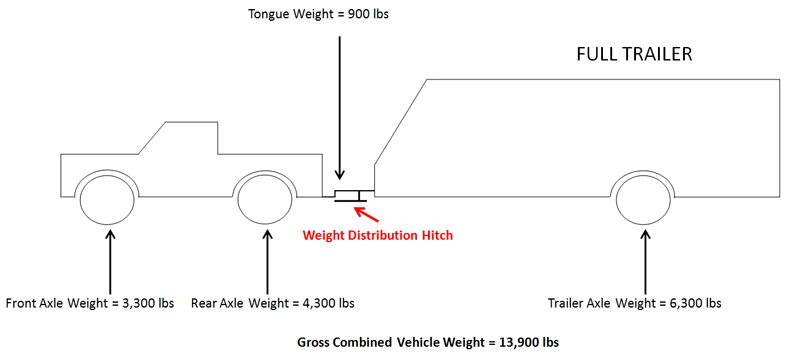 In the example, I used nice round numbers an example. There are so many variables on some many tow vehicles and trailers, so just use the numbers to understand the theory.
In the example, I used nice round numbers an example. There are so many variables on some many tow vehicles and trailers, so just use the numbers to understand the theory.
We have taken the 900 lbs of tongue weight and distributed 300 lbs to the front axle of the truck and 300 lbs to the trailer axle. Now everything is nice and level.
The chart below shows the difference in the fully loaded trailer when connected to our truck with the WC hitch and then the WD hitch.
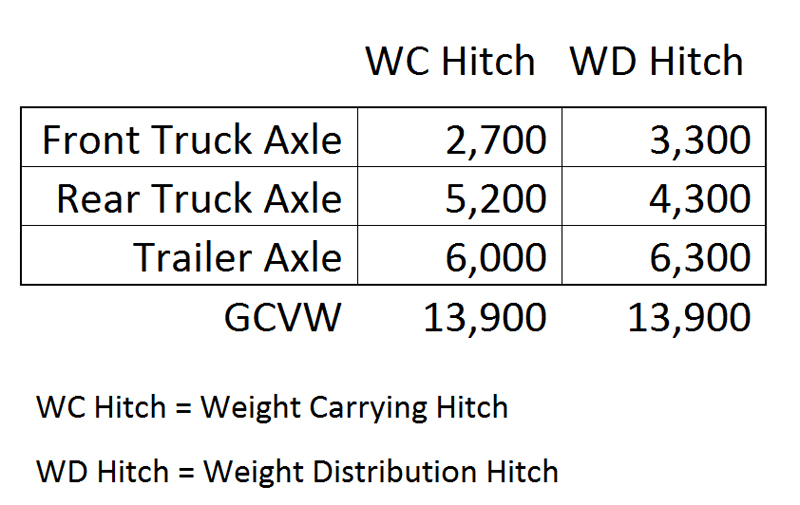
Let’s take a closer look at a WD hitch.
To start out, we need to tilt the angle of the hitch ball back, so the spring arms (wheelbarrow handles) point down. This varies by hitch, tow vehicle and trailer. Concentrate on the theory, remember?
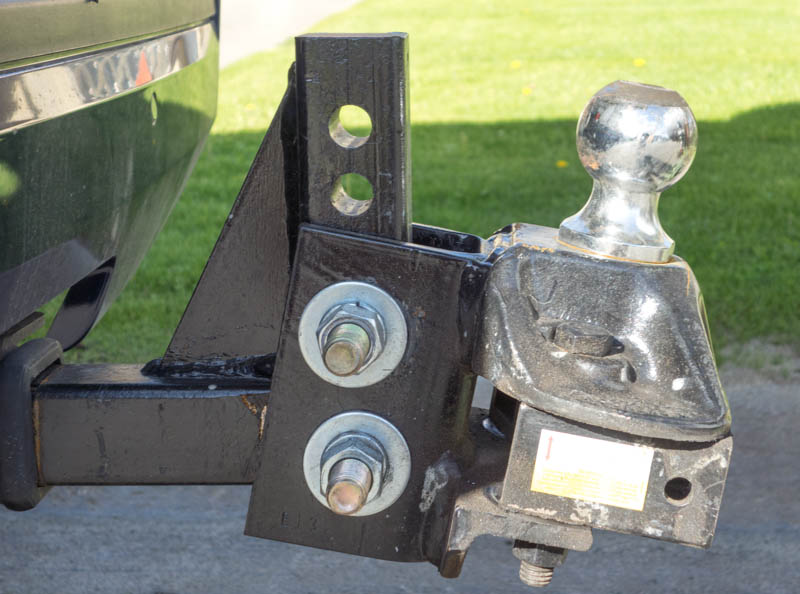
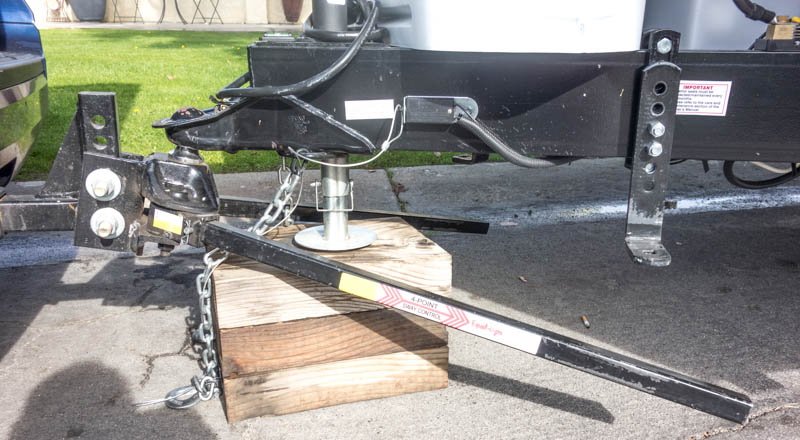
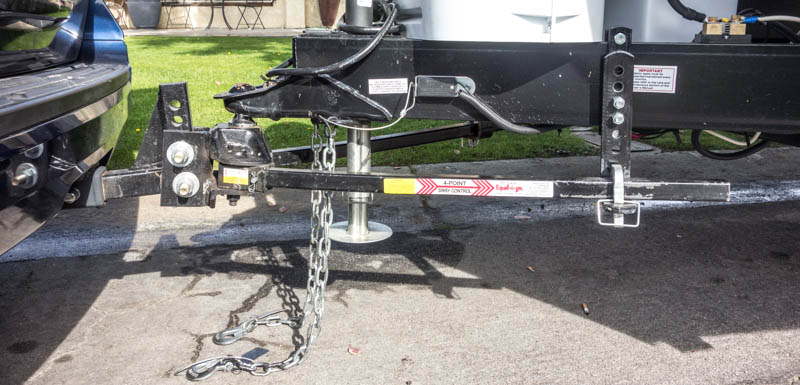
Does a Weight Distribution Hitch Reduce the Tongue Weight?
When we start calculating weight distribution we need to know that we have a complex lever with two fulcrum points – the trailer axle and the truck rear axle. Now we need to measure the length of our levers, which are ball to truck rear axle, truck rear axle to truck front axle, ball to trailer rear axle, and blah, blah, blah, blah, blah, blah, blah, blah.
It is difficult to explain, so here is the Cliff Note’s version in a picture below.
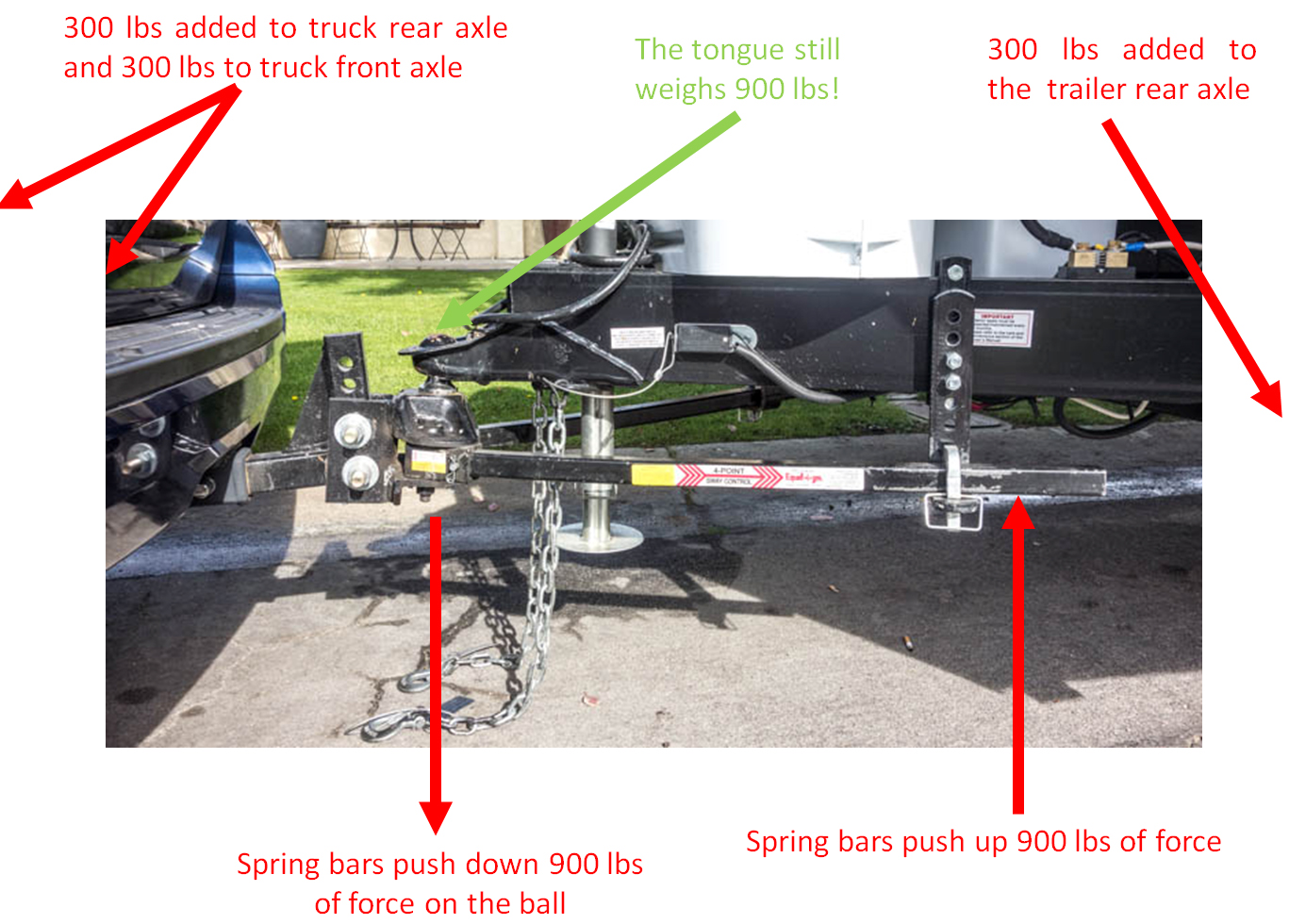 Don’t worry if the above picture doesn’t make sense. Go get a beer and come back to read the rest of the story. 🙂
Don’t worry if the above picture doesn’t make sense. Go get a beer and come back to read the rest of the story. 🙂
Bottom Line of All the Calculations…
The tongue weight doesn’t change. It applies the same force on the hitch. And in our case, it is still 900 lbs.
Weighing Your Rig
Okay, what is the easiest way is to make sure all the axles (truck and trailer) don’t exceed the vehicle and trailer max gross weight? This is easy. Go to a truck stop and weight it on a CAT Scale. The scale can weight 3 axles as shown below, and will provide you with a total combined vehicle weight.
Now unhitch the truck and weigh it by itself. Subtract the unhitched truck weight from the combined weight and you know how much the trailer weighs. Now you know:
- Combined weight
- Truck weight
- Trailer weight
- Weight of each axle
The only thing you don’t know at this point, is the trailer tongue weight. You can make a 3rd weight on the scales with just the trailer tongue on a pad, or the trailer axle on the pad and the tongue of the pad. Or you can buy a Sherline tongue scale on the Internet. Or you can fabricate one with a bathroom scale. Again, Google is your friend.
Our Trailer
Our trailer had this factory specification from the brochure:
The hitch already exceeded our capacity of 920 lbs for a WD hitch with the trailer empty!
Plus the specs did not include any options. The final delivered weight was 6,560 lbs.
This did not include propane tanks or batteries (240 lbs), which had to be added to the front tongue adding all the weight to the tongue. And we hadn’t weighed anything yet.
Holy Batshit, we must be stupid!!
To be continued…
This website may be compensated for linking to other sites for sales of products. As an Amazon Associate I earn a small fee from qualifying purchases at no additional cost to the purchaser.
